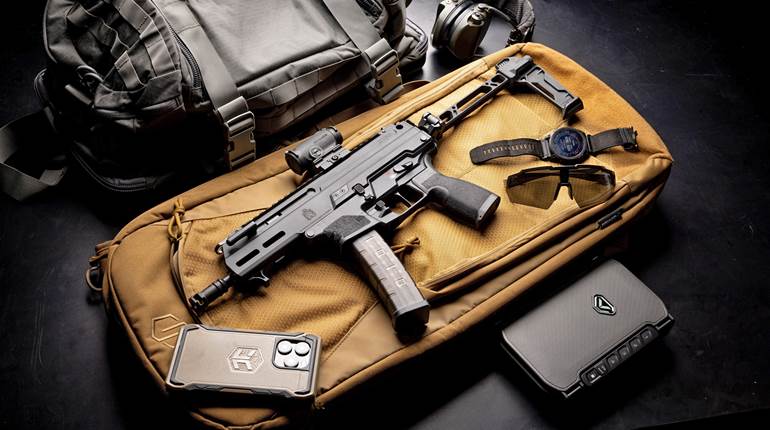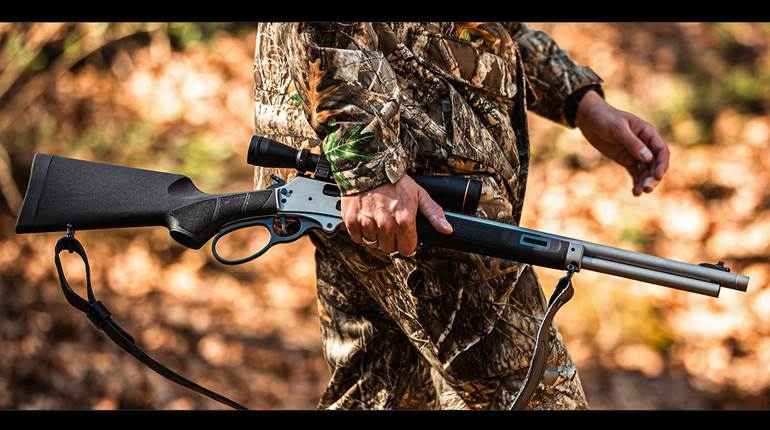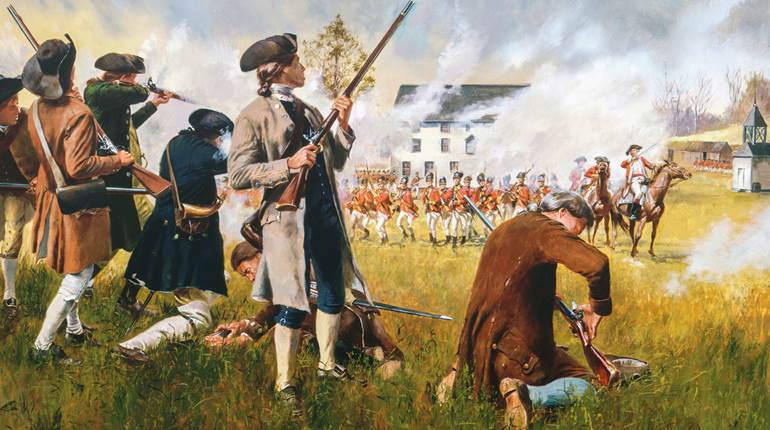Nitro Hunter. The grandiose name stamped in the side of the receiver is in stark contrast to the rest of the petite rifle, with its slender furniture, tiny action and slim octagonal barrel. Its finish is worn to a patina in most places, the forearm is cracked and the rear sight elevator has long since gone missing. It’s not the kind of firearm that would catch your eye at a gun show or have a lot of value to a collector. It has a lot of value to me, though, because it was my granddad’s rifle.
You can learn a lot about your family history through “gun genealogy”—the firearms your ancestors owned and passed down and the stories that go along with them. “Nitro Hunter” was the store brand name used by the Belknap Hardware and Tool Company of Louisville, Ky. on its line of utilitarian rifles and shotguns. Hopkins & Allen was the actual manufacturer of my granddad’s rifle, a variant of their No. 932 falling block chambered in .32 rimfire. It was the type of affordable and functional tool that a farmer like him would own. Probably purchased by his father from a local hardware store at the end of the 19th century, as the family’s only rifle, it supplied rabbits for the stew pot, killed hogs at butchering time and protected the garden from varmints.
Long after my granddad was gone, the Nitro Hunter still figured large in the stories my grandma told me about him, from the time he used it to dispatch a threat to his lambs to how it was the first step in a process that ended with sugar-cured hams. Just handling the rifle and hearing the stories, however, was never enough for me to fully understand its importance to my family’s story. I wanted to shoot it. And therein lay the problem. 
The author's grandfather's Nitro Hunter, a store brand rifle made by Hopkins & Allen, along with an original box of .32 rimfire ammunition and three reloadable rounds by H&C Collection.
The .32 rimfire was introduced by Smith & Wesson around 1860 and would be made in Short, Long and Extra Long or Long Rifle loadings. In its original Long form, 13 grains of black powder propelled a 90-gr. solid lead bullet to 1,080 f.ps. Modern rimfire ammunition for calibers larger than .22 is virtually nonexistent. In the decade after World War II, most American manufacturers stopped producing it. Canadian Industries Limited (CIL) made the ammunition under its Canuck brand a little longer. Lack of ammunition forced the Nitro Hunter into obsolescence for my granddad. When it became impossible to buy ammo, he was forced to replace it with a .22 Remington 514, an equally utilitarian firearm. He kept the Nitro Hunter though, because he was the frugal kind of person who never got rid of anything. Like a long outdated piece of farm equipment sitting in a shed, you never know when something might become useful again. So the rifle languished on the rack in the small room off of his kitchen. 
The H&C Collection reloading kit uses .22 blanks as primers in reloadable brass cases to handload ammunition for obscure rimfire calibers.
Over the years, .32 rimfire ammunition became available from time to time. Starting in the late 1980s, the Navy Arms company imported a few lots of .32 and .41 rimfire made by CBC of Brazil, but by 2009 CBC production of the big-bore rimfires had also ended. Original .32 rimfire cartridges (even the Navy Arms loadings) are now a collector’s item that, at over five dollars a round or $100 a box, are too expensive for plinking. An Internet search for affordable .32 rimfire ammo turned me on to a different solution. I found H&C Collection, a company making reloading kits in .32 (both Short and Long versions), .38 and .41 rimfire calibers. Based in France, H&C Collection makes a whole line of reloading products to breathe life back into obscure calibers, from 10.6 Reichrevolver to 9 mm Lefauchex Pinfire. How does one reload a rimfire you ask? H&C’s solution is to machine a brass case that has an off-set primer pocket. A .22 blank is inserted into the pocket with its rim sitting on the outside edge of the case’s rim where the firing pin will contact it. After firing, the spent blank can be removed and the case used over again.

Looking to get Granddad’s rifle back in action, I ordered one. Shipped in a pine box, the H&C kit includes a loading/resizing die, bullet seater, deprimer and powder measure. Also included are 24 cast bullets and 12 reloadable cases. Loading the cases is easy using the supplied tools. The process is in the reverse order of typical handloading. Using a nylon hammer and the seating tool, the cast bullets are seated into the case up to the heel. With the bullet installed, the measured powder is inserted into the case through the primer pocket. It is recommended to only use black powder in these antique rimfires. Though the instructions say that any grade of powder will work, I used FFFg as appropriate to the .32 bore size. 

The H&C Collection rimfire reloading kit uses a machined brass case with an off-set primer pocket (right, compared to original .32 rimfire cartridge, left). A .22 blank is used as a primer. Using a plastic mallet, the bullet is seated into the case.
The last step—seating a primer (the .22 blank) in an already loaded cartridge—is the most ticklish. Though the instructions insist this can be done with finger pressure, I found that hand seating would leave the blank slightly above flush. I ended up using the nylon hammer head to gently seat the blanks all of the way. Priming blanks are not supplied with the kit when it is shipped to the U.S. and it should be noted, only the “acorn”-style .22 blanks work. Short and Long .22 blanks, which seem to be more common in gun shops these days, are too long for the case’s primer pocket. As a final step, because original .32 Rimfires used a waxed or lubricated projectile, I filled the groove on the supplied bullets with muzzleloading lube.
As with all antique firearms, old rimfires should be inspected by a competent gunsmith before attempting to shoot them. Most are over a century old and many have experienced a lifetime of neglect and the corrosive effects of black powder. When facing the possibility of reducing a family heirloom to a pile of scrap iron, it’s best to err on the side of caution. 
Loaded cartridges in hand, I headed to the range. I had raised the rifle to my shoulder, cocked the hammer and looked over the sights many times over the decades, but now for the first time there was a live cartridge in the chamber. The satisfying sulfur smell of real black powder greeted me when I pulled the trigger. The old Nitro Hunter was back in business. 

Unlike a factory-loaded rimfire cartridge, which has priming compound in the entire rim, the blank primer in these reloadable cases is only in one spot for the firing pin to contact. This means care must be taken when loading the cartridge into the chamber to make sure that the primer is properly positioned so that the firing pin will strike it. Failure to do this could result in damage to both the firearm and the case. This is easy to do in single shot rifles, or revolvers, but in repeating firearms, like a lever action, the cartridges must be loaded singly, directly into the chamber to make sure they are in the correct orientation for ignition. The single priming spot design of the reloadable cases also preclude their use in firearms that use a two-point firing pin system.
The reloadable case system proved reliable. In all my testing, I only experienced a single misfire, which I attribute to the blank. By slightly repositioning the cartridge, so a different spot on the blank would be struck by the firing pin, it went off on the second try.



Preparing the fired cases for reloading is equally simple. The supplied rod pushes out the spent blank primer. If resizing is necessary, the opposite end of the bullet-seating die is used. The instructions recommend tapping the die onto the case with the nylon hammer or using a bench vice. I used standard reloading lubricant on the cases before resizing them with a vice, taking care not to damage the thin edge of the rim at the primer pocket. The cases should be cleaned in soapy water to remove the lube and black powder residue before they are reloaded. 

The supplied cast bullets are a .316” diameter heeled Hensley Gibbs design and weigh about 87 grains each. The kit’s measure meters out 7.5 grains of black powder, which completely fills the Long cases because of the space lost to the off-set primer pocket. This makes for a load that performs just shy of original .32 Short ballistics. Over the chronograph, they averaged around 900 f.p.s. from the 24” barrel of the Nitro Hunter.
The H&C Collection .32 rimfire reloading kits sell for around $160, depending on the exchange rate with the Euro. Extra cases are available for $28 a dozen and cast bullets for $24 a hundred. For those looking for a few rounds in order to test fire an antique firearm, H&C offers “trial” kits, which are comprised of five cases with the bullets already seated. The purchaser need only add powder and primer to make a loaded round. 
Many .32 rimfire firearms, like this Remington No. 4 Rolling Block, were made as takedown models. The H&C Collection reloading kits gets them shooting again.
I’ve inherited several old tools that belonged to my ancestors. In the disposable, single-use, box-store world that we live in, it’s amazing that a hammer or saw made over a century ago has survived and can still cut boards, sink nails, and be passed down from generation to generation. The Nitro Hunter is one of these tools. Granddad’s hedge that his old rifle would become useful again has paid off. There are a lot of old big-bore rimfires out there like it. They have little collector value, but are priceless to the people who own them. The H&C reloading kit can transform these old wall hangers back into functional firearms. By shooting them, we’re not only connecting with our past, but adding a new chapter to the story.
























